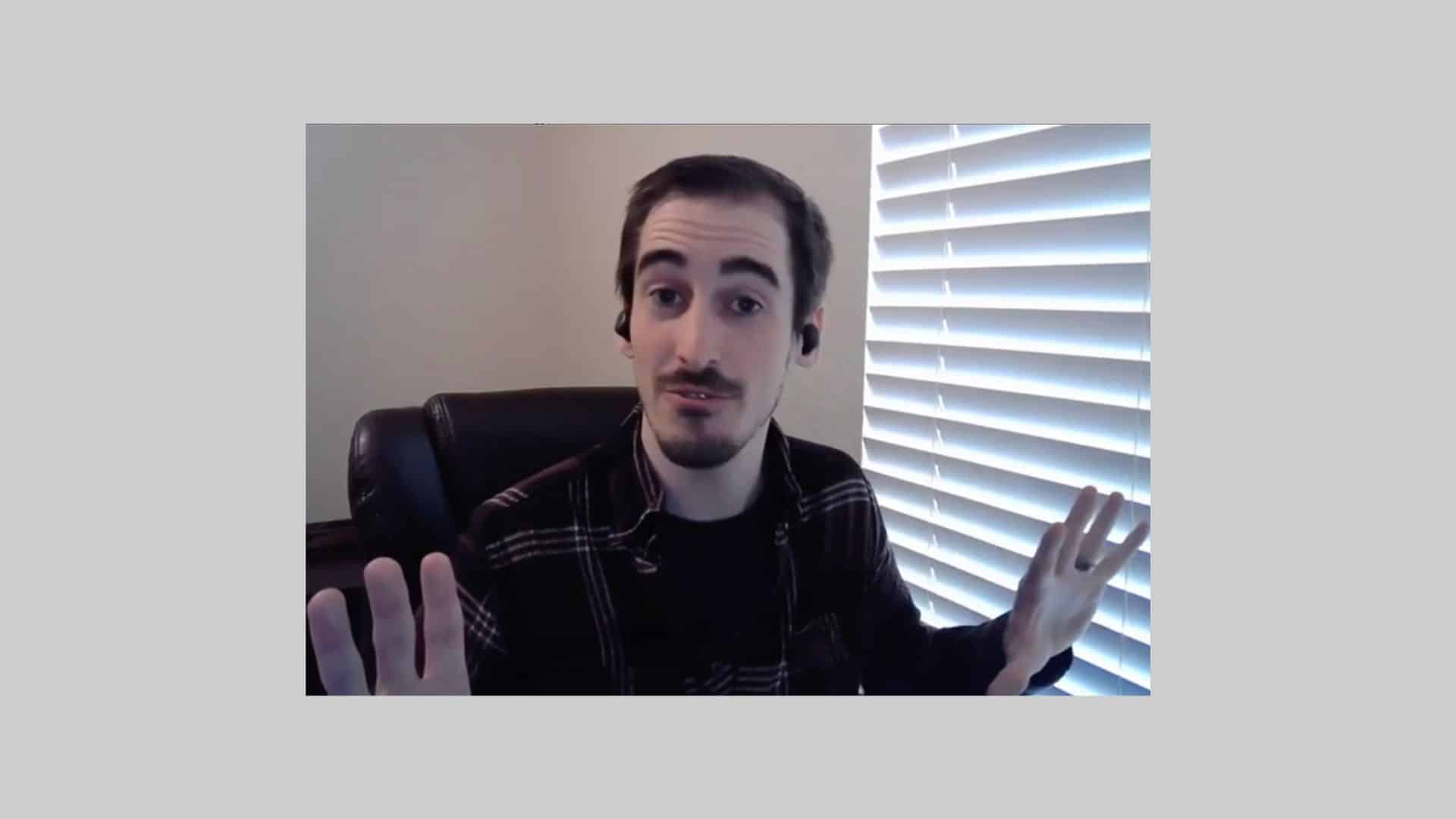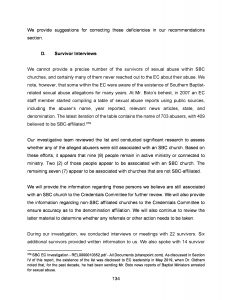We are not minimizing the seriousness of the instances in which abuse has occurred. Nor are we sweeping the problem under the rug. The point here is to get to the truth. Looking at the SATF report, Kyle Whitt helps us do that.
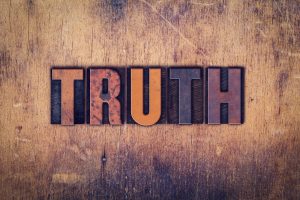
Here is the entirety of segment 2 (both audio track and text) of the three audio segments I have pulled from Kyle’s video (posted below). This segment is 17 and-a-half minutes long (the time listing on the audio bar likely is incorrect).
Let’s look at another section of this report. This is the big section. So this is about the amount of abuse — that there’s this big issue of abuse (that’s one of the things that’s trying to be established) — but also the cover-up. So this hits both. And I think this is kind of one of the shockingly deflating points of this investigation. Not that it’s deflating to us, I mean that it deflates the investigation, the assumption. And this really goes into the assumption that this is a huge issue. They make it very clear that they are going into this with a hypothesis rather than from a neutral standpoint. So,
Page 134 of the SATF report:
The report: We cannot provide a precise number of the survivors of sexual abuse within SBC churches,…
Kyle: That is not a necessarily problematic statement, but it starts to get more and more problematic as it goes on, because it shows that they’re assuming that the number is high.
The report: …and certainly many of them never reached out to the EC about their abuse.
Kyle: This is an investigative report. Those sentences, or that sentence is not really the best fitting in here. Because they’re trying to establish facts, not present opinion. That doesn’t establish a fact. But continuing on,
The report: We note, however, that some within the EC [the Executive Committee] were aware of the existence of Southern Baptist-related sexual abuse allegations for many years.
Kyle: Ooooo! Now they’re going to get into the dirt, the secret list that came up in discussions before this report was commissioned.
The report: At Mr. Boto’s behest,…
Kyle: I told you he’d come up. At his behest
The report: in 2007 an EC staff member started compiling a table of sexual abuse reports using public sources,
Kyle: So, Mr. Boto encourages the staff member: Make this list. So, this guy that that they’re saying [on page 7 of the report] is trying to cover up things [protecting and supporting abusers], is trying to make a list of abuse. I don’t get how that would be to then cover-up, I’m not sure. It’s kinda funny that they would use him on one side and then it kind of looks like he’s doing the exact opposite later. But it’s not his “secret list” that the EC was just holding behind closed doors looking at [or looking to protect or support abusers]. It was commissioned by one guy and compiled by a single staff member. And that’s reflected in other places, as well. This was just a staff member doing this. So he was…
The report: …compiling a table of sexual abuse reports using public sources, including the abuser’s name, year reported, relevant news articles,
Kyle: And that really seems to be the crux of how this guy was getting his information, was news articles.
The report: state, and denomination.
Kyle: Denomination! If it’s about the SBC, why is he collecting [information about] denomination? That’s because
The report: The latest iteration of the table contains the name of 703 abusers,
Kyle: OK. Investigative report. They’ve done a good job for the most part of saying alleged and, you know, using lawyer talk — which is good. You know, you’re supposed to do that.
The report: …contains the name of 703 abusers,
Kyle: But this is a list of both allegations and of conviction. The full list is redacted of anyone that’s not proven. But it indicates that some people were exonerated, but were still on that list. So it’s not 703 abusers. Anyway, out of those 703,
The report: …with 409 believed to be SBC-affiliated.
Kyle: believed to be SBC-affiliated is super important because, well, look at the list a tiny bit. We cannot go through the whole thing. I’ve not gone through the whole thing, but only 409 are listed as probably SBC. They said it that way because the person who is writing it sometimes just said not sure if SBC. That’s the level of scholarship, of deep journalism that goes into that list, the secret list, the list that’s so important to this.
The report: Our investigative team reviewed the list and conducted significant research to assess whether any of the alleged abusers were still associated with an SBC church.
Kyle: Now, if they did that, that’s super important. We need to have all that information, because it really sheds a lot of light on the list. The list we’re given is not a thoroughly researched and reviewed list. If they did that thorough research and review, we don’t have it.
The report: Based on these efforts, it appears that nine (9) people
Kyle: So, out of 703, 9 people —
The report: remain in active ministry
Kyle: Now, those could be accused people. Those could be acquitted people. Those could be guilty people. They don’t establish that. So 9 people remain in ministry
The report: or connected to ministry.
Kyle: I don’t know what connected to ministry is [or means]. This is not a Christian organization compiling this. They make that clear throughout this, that they don’t fully understand the structure and nature of the SBC or just of Christianity in general. So they need to define their terms. And even when they define their terms [things remain unclear]. Reading this report, again, it kind of slipped in and out of things. It makes things unclear.
The report: Two (2) of those [9] people appear to be associated with an SBC church.
Kyle: Again, appear to be associated with an SBC church — They need to get to the bottom. They need to have, again, comparing it to the Ravi Zacharias one. There’s always a degree of appear, allege, but the evidence they were presenting was pretty much here is the evidence. Not here is the potential, but here is the evidence. We’re going to give you the evidence. We’re going to put the evidence in your hands so you can see what’s going on. They really, really need to establish that those two people are in active ministry, are the accused people, are guilty, and are in an SBC church. That’s crucial to what they’re trying to establish. That’s crucial to the investigation. But continuing on,
The report: The remaining seven (7) appear to be associated with churches that are not SBC-affiliated.
Kyle: Again, it drives me bonkers. Why is it so vague? But as for this huge systemic issue, this secret list, all this stuff — 703 names boils down to two. We’ll give them the two. Should the two be taken care of? Yes! But that is two, not churches, that is two individuals among over 40,000 churches. And, so just currently still active, so we’ll shorten it to just today — not the whole list, because the whole list goes back decades. Two people still active among over 40,000 churches, well over 100.000 people in ministry. And that’s very, very conservative. It’s much, much higher than that.
Let’s just, for the sake of having an easy number to work with, two out of 100,000. That is lower than I thought it was going to be! Those two need to be taken care of. We need to always be working to drive that to zero. But for what this investigation was all about, for what it was supposed to establish, that’s shockingly low.
The report: We will provide the information regarding those persons we believe are still associated with an SBC church to the Credentials Committee for further review.
Kyle: We’ll see what comes of that.
The report: We will also provide the information regarding non-SBC affiliated churches to the Credentials Committee to ensure accuracy as to the denomination affiliation.
Kyle: One point seven million dollars, and they cannot do that on their own. If I had the names of the churches, I could go figure out if they’re SBC-affiliated. And it wouldn’t be hard. It’s not hard to find out if a church is SBC-affiliated. There are some “edge” cases that provide complexity. But in general, it’s not hard. If you want to figure that out, you can figure that out. The SBC keeps records of those things. And, again, that would be just using the publicly available church-finding data. They have access to all the internal data. The fact that the couldn’t blows my mind. One point seven million dollars and they can’t do the digging that they were supposed to do.
The report: We will also continue to review the latter material to determine whether any referrals or other action needs to be taken.
Kyle: Let’s read a tiny bit more to get to the context.
The report: During our investigation, we conducted interviews or meetings with 22 survivors.
Kyle: [Twenty-two survivors is] so incredibly low of a number over the course of decades, as this report goes back at least 30 years. I wish it was zero, but I’m glad it’s as low as it is.
The report: Six additional survivors provided written information to us. We also spoke with 14 survivor advocates and six family members of survivors.
Page 135 of the SATF report:
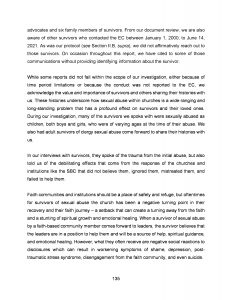
Kyle: I don’t really care about survivor advocates. Family members is a little bit different. I don’t really know how survivor advocates really adds to interviews with survivors. I’m saying just in terms of establishing quantities here.
The report: From our document review, we are also aware of other survivors who contacted the EC between January 1, 2000, to June 14, 2021. As was our protocol…we did not affirmatively reach out to those survivors. On occasion throughout this report, we have cited to some of those communications without providing identifying information about the survivor.
Kyle: So, again, they’re trying to establish [that there is] this huge quantity, yet the amount they’re able to interview of actual survivors is 22, plus an additional 6, so 28 survivors. And then an unknown amount of family members of survivors, because they lump that together with advocates. That’s tiny! For a 288-page document that is tiny! That is not a very good sample size, yet they recommend big, huge, sweeping changes to the SBC. Which, again, as many people point out, that was the goal of many who put this forward. Let’s read a tiny bit [more], because I want to show this report, how bad this report is. As a report, again, if you want to read a much better one, go read the one about Ravi Zacharias, and then compare it to what we’ve read here. This is so opinionated, where, at the minimum, it just did not need to be 288 pages. It could have been much more concise and established its points better.
The report: While some reports did not fall within the scope of our investigation, either because of time period limitations or because the conduct was not reported to the EC, we acknowledge the value and importance of survivors and others sharing their histories with us. These histories underscore how sexual abuse within churches is a wide-ranging and long-standing problem that has a profound effect on survivors and their loved ones.
Kyle: What does this have to do with the investigative report? This is getting into opinion; it’s preaching at this point. Why is the report preaching?
The report: During our investigation, many of the survivors we spoke with were sexually abused as children, both boys and girls, who were of varying ages at the time of their abuse. We also had adult survivors of clergy sexual abuse come forward to share their histories with us.
Kyle: I don’t know what they’re establishing there. They’re not clarifying anything. At least they’re clarifying incredibly little.
The report: In our interviews with survivors, they spoke of the trauma from the initial abuse, but also told us of the debilitating effects that come from the response of the churches and institutions like the SBC that did not believe them,
Kyle: Wait! This is about the SBC in particular, so I’m confused about that sentence, why it says “of the churches and institutions like the SBC.” At the minimum that sentence is confusing. It makes it seem like they’re talking to more than just SBC people, but they’re trying to lump it all with the SBC. They may not be saying that, but it’s very unclear. Anyway
The report: [did not] believe them, ignored them, mistreated them, and failed to help them.
Kyle: Now, one thing to be clear: Only God can help people. Only God can help these people. We are supposed to be [His] hands and feet, but we do not do the actual helping. We cannot do the actual healing. We can only help bring people to God and help them on that journey. Now we say that because this document is starting to preach and preach in a position, and the position is not Christian; and I just want to clarify that we are not secular – we are Christian. We are to be helping these people, but helping them by discipling them. That means taking them to God. And then, again, we’re going to read just a tiny bit more, just a few more sentences because it really gets into the preaching, not the investigation.
The report: Faith communities and institutions should be a place of safety and refuge, but oftentimes for survivors of sexual abuse the church has been a negative turning point in their recovery and their faith journey — a setback that can create a turning away from the faith and a stunting of spiritual growth and emotional healing. When a survivor of sexual abuse by a faith-based community member comes forward to leaders, the survivor believes that the leaders are in a position to help them and will be a source of help, spiritual guidance, and emotional healing. However, what they often receive are negative social reactions to disclosures which can result in worsening symptoms of shame, depression, post- traumatic stress syndrome, disengagement from the faith community, and even suicide.
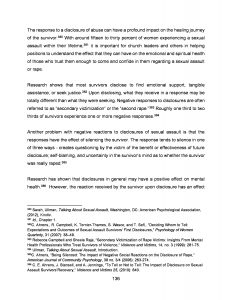
The response to a disclosure of abuse can have a profound impact on the healing journey of the survivor.
Kyle: That is true. If they come forward with, Hey, I was abused by this person, and the response is, No, you weren’t, shut up! obviously they’re going to be pretty traumatized by that. If it’s Oh, you were! Oh, you poor thing! I believe you one hundred percent, that’s also going to traumatize them in the long run as well. You need to come alongside the person, and you need to get them help. Help means getting to the bottom of things, getting to the truth so that justice can be served and then bringing them along the journey, a discipling journey of healing.
The report: With around fifteen to thirty percent of women experiencing a sexual assault within their lifetime,
Kyle: I’m going to call bogus on that right now based on a lawyer friend of mine who’s made it very clear to me that sexual assault [note the term assault, not abuse] is a very specific legal term. It is not general. It does not mean it the way we use it in common parlance. It means something very specific in a legal sense. So in a document like this, they should be following investigative practices; they should be very legal in how its using its terminology. To say that is very dubious.
Also, “fifteen to thirty percent” is a gigantic window and shows a huge degree of error. I have not looked into that. I’m just saying sexual assault is something very, very specific. And, yes, sexual abuse is incredibly common, way too common, among both men and women. And, in fact, it’s more common because of all the LGBTQ nonsense which is just riddled with sexual abuse, and it, in its very nature is a type of sexual abuse. So, it’s incredibly common. It should to be, but, again, it kind of raises the question, Why are they bringing this up?
The report: [I]t is important for church leaders and others in helping positions to understand the effect that they can have on the emotional and spiritual health of those who trust them enough to come and confide in them regarding a sexual assault or rape.
Kyle: Again, it’s just opining. It’s preaching to the Southern Baptists, [saying] you guys aren’t doing a good job, you need to do this. It also, again, confuses things. “Fifteen to thirty percent of women” — it’s not saying women in the church. It’s not saying women in the SBC. It’s using things in a very confusing way. It’s opining; it’s just going on about opinion, what it thinks. It’s bad! It’s bad of investigative reporting.
OK, go read the one about Ravi Zacharias; compare it to this. There is some of that grandstanding. There’s always going to be some. But you should see more of — we’re establishing the beginning, and a conclusion. [In a better report,] there’s going to be a bit more of we need to communicate with you in the beginning and the end to clarify things, but we should still be professional. This document isn’t! And this is in the middle. This is page 135.
This page is part of a larger Word Foundations article.
Sexual Abuse Task Force webpage
Guidepost Solutions SATF report
